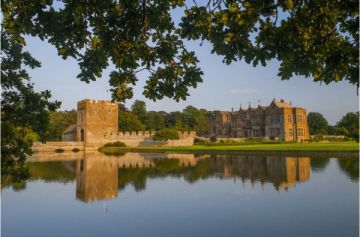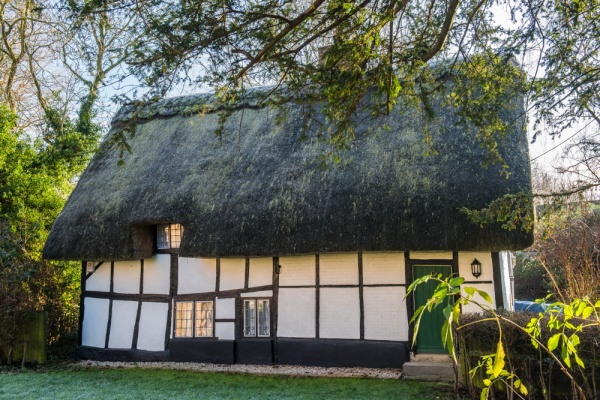
The pretty village of Dorchester-on-Thames (not to be confused with the county town of Dorchester in Dorset!) stands near the confluence of the rivers Thame and Thames. The area was settled at least as early as the Neolithic period, and on the outskirts of Dorchester are the remains of an Iron Age hillfort at Dyke Hills. Across the Thames, a Bronze Age hillfort tops one of the twin peaks known as the Wittenham Clumps.
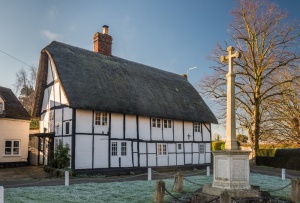
The Romans were drawn to Dorchester for its strategic position near the Thames. they built a walled town here, defended by water on three sides and linked by road to the fort at Alchester.
The event that really put Dorchester on the map came in AD 634, when St Birinius arrived on a mission to convert the pagan inhabitants of the Thames Valley to Christianity. Cynegils of Wessex granted lands at Dorchester to Birinius, who established a bishopric here. Tradition says that Birinius baptised the king in the Thames at Dorchester.
Dorchester then became not only the ecclesiastical centre but the administrative centre for Wessex, at least until the bishopric was transferred to Winchester.
The Bishop of Leicester transferred his seat to Dorchester in AD 875, and for two centuries the See of Dorchester stretched from the Humber to the Thames, a vast swath of territory. But the end would come in 1075 when the Norman Bishop Remegius moved the see once more, to Lincoln, and Dorchester dwindled in importance.
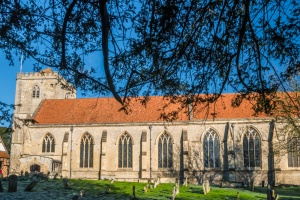
The church established by Birinius was rebuilt several times, and was completely rebuilt and enlarged in AD 1140 to serve a community of Augustinian canons. The scale of the church was at odds with the size of the village, which remained small. The abbey was dissolved by Henry VIII in 1536, but the abbey church was saved from destruction by a local man named Richard Beauforest, who bought the building from the crown for the princely sum of £140, and gave it to the village in his will.
Beside the church is the 14th-century guest house which now serves as a heritage museum covering the village. Bult into the abbey itself is the Cloister Gallery, a permanent exhibition on the history of this beautiful building as told through its carved stones.
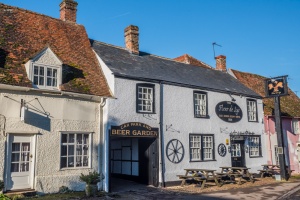
Almost opposite from the abbey's timber-framed lych gate is The George, a galleried coaching inn dating to 1495. The George served coaches travelling on the main road linking London to Oxford and Gloucester, which became one of the first toll roas in England. At one time there were 10 coaching inns, but now only the George and the nearby White Hart remain.
If you enjoy picturesque cottages, then a stroll around Dorchester will be a slice of heaven, for within a few minute's stroll are dozens of attractive thatched and timber-framed cottages. Many of the most interesting historic buildings are listed on a very good information plaque found near the public washrooms off Bridge End.
Outside the churchyard is The Toll House, an octagonal brick building erected in 1820. Tolls were collected until 1873, and the building now houses an architectural firm. At Bridge end is a brick and flint cottage with the date 1715 over the door. Further along Bridge end is the Roman Catholic Church, built in 1848 by William Wardell, who trained with AW Pugin, the architect of the Palace of Westminster.
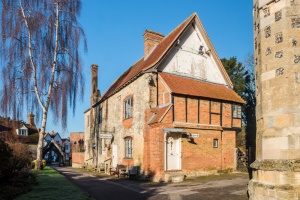
now the Dorchester Museum
On Samian Way is a late medieval cruck-framed cottage, and on Rotten Row is the Fleur-de-Lys pub, where you can see a solitary timber cruck, which gives away the building's ancient origins. On the corner of Queen Street and High Street is an 18th-century house restored in 1878 by Sir George Gilbert Scott to create a Missionary Training College.
A bit further along the High Street is the White Hart Hotel, notable for its distinctive herring-bone brickwork. You can't miss the large date of 1691 on the facade, but this only connotes the date the exterior was refaced in brick.
Under the brick is medieval wattle and daub. At the junction of High Street and Watling Lane stands the war memorial, on a small triangular green in front of yet another attractive timber-framed building. Nearby is an unusual thatched cob wall, and just north is Bishop’s Court Farm, said to be the site of the Bishop's Palace in the days when Dorchester was at the centre of its own bishopric.
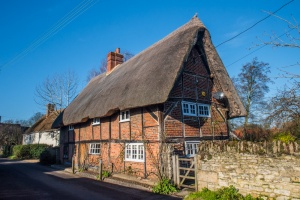
A signed footpath from Watling Lane takes you across riverside fields to Day's Lock, a popular Thames lock and for many years the site of an annual Pooh-sticks championship. A footbridge leads over the river to Little Wittenham, where the medieval church stands at the base of more paths that lead through a nature reserve and up Wittenham Clumps.
South of Dorchester, between the village and the hamlet of Overy, lies the Hurst Water Meadow, a beautiful riverside nature reserve covering 18 acres. Access is by footpath off Manor Farm Road, behind the Abbey.
TV viewers will recognise Dorchester from its many appearances in the popular series 'Midsomer Murders'. The George Hotel has appeared in 2 episodes, the Fleur-de-Lys in one, but the most popular location for the series was the post office on High Street, which featured in 3 episodes - representing 3 distinct fictional villages.
I've visited Dorchester on Thames numerous times, and every time I find something new and fascinating. This truly is one of the most attractive and interesting historic villages in England, and one of the most enjoyable.
About Dorchester-on-Thames
Address: Dorchester-on-Thames,
Oxfordshire,
England, OX10 7HL
Attraction Type: Village
Location: On a minor road off the A4074 3 miles north of Wallingford
Website: Dorchester-on-Thames
Location
map
OS: SU578942
Photo Credit: David Ross and Britain Express
POPULAR POSTS
HERITAGE
 We've 'tagged' this attraction information to help you find related historic attractions and learn more about major time periods mentioned.
We've 'tagged' this attraction information to help you find related historic attractions and learn more about major time periods mentioned.
Find other attractions tagged with:
19th century (Time Period) -
NEARBY HISTORIC ATTRACTIONS
Heritage Rated from 1- 5 (low to exceptional) on historic interest
Dorchester Abbey - 0.1 miles (Historic Church) ![]()
Little Wittenham, St Peter's Church - 0.9 miles (Historic Church) ![]()
Chiselhampton, St Katherine's Church - 3.2 miles (Historic Church) ![]()
Nuneham Courtenay, All Saints Old Church - 3.3 miles (Historic Church) ![]()
Wallingford Castle - 3.4 miles (Castle) ![]()
Wallingford, St Mary le More Church - 3.5 miles (Historic Church) ![]()
Wallingford, St Peter's Church - 3.6 miles (Historic Church) ![]()
Wallingford, St Leonard's Church - 3.7 miles (Historic Church) ![]()
Nearest Holiday Cottages to Dorchester-on-Thames:
Wallingford, Oxfordshire
Sleeps: 4
Stay from: £519.00 - 2622.00
More self catering near Dorchester-on-Thames









